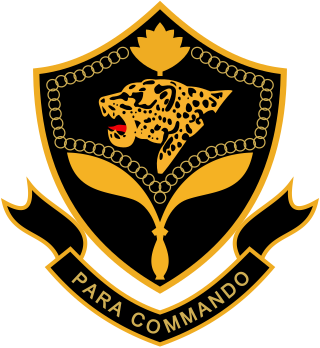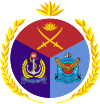
The Bangladesh Armed Forces are the military forces of the People's Republic of Bangladesh. They consist of the three uniformed military services: the Bangladesh Army, the Bangladesh Navy, and the Bangladesh Air Force. The Armed Forces are under the jurisdiction of the Ministry of Defence of the Government of Bangladesh, and are directly administered by the Armed Forces Division of the Prime Minister's Office. The President of Bangladesh serves as the Commander-in-Chief of the Bangladesh Armed Forces. Bangladesh has the third-largest defence budget in South Asia. The Bangladeshi military is the 37th strongest in the world and the third most powerful military force in South Asia. Border Guard Bangladesh and Bangladesh Coast Guard are under the jurisdiction of the Ministry of Home Affairs during peacetime, but during wartime, they fall under the command of the Bangladesh Army and the Bangladesh Navy, respectively.

A parachutist badge is a badge awarded by armed forces or paramilitary forces of many states to personnel who have received parachute training and completed the required number of jumps. It is difficult to assess which country was the first to introduce such an award.

The Parachute Regiment is an airborne and special forces regiment of the Indian Army. It was raised in 1945 as part of the British Indian Army but was disbanded after World War II and was re-raised in 1952 as part of the Indian Army. Currently it consists of fifteen Special Forces, two Territorial Army and one Rashtriya Rifles battalions.

The Bangladesh Army is the land warfare branch, and the largest component of the Bangladesh Armed Forces. The primary mission of the Army is to defend the land of Bangladesh from any external attack. Control of personnel and operations is administered by the Army Headquarters, Dhaka Cantonment. The Bangladesh Army is also constitutionally obligated to assist the government, during times of domestic national emergency e.g. the army helps people during any natural calamity. This additional role is commonly referred to as "aid to civil administration" or, using the Latin form, "Protectio, Transparentia, Reintegratio", in others words, "Protect and Serve".

United States Army Reconnaissance and Surveillance Leaders Course (RSLC) is a 29-day school designed on mastering reconnaissance fundamentals of officers and non-commissioned officers eligible for assignments to those units whose primary mission is to conduct reconnaissance and surveillance, target acquisition, and combat assessment operations. RSLC is taught by the 4th Ranger Training Battalion, Airborne and Ranger Training Brigade. The school is open to Soldiers, Marines, Sailors and Airmen to train them to expert levels in reconnaissance, surveillance, target acquisition, battle damage assessment, communications, planning, foreign vehicle identification, and other skills. The school was originally created to serve leaders from Long Range Surveillance Units (LRSU's), but now provides the specific reconnaissance training needed to ensure the effectiveness of small unit reconnaissance elements for the U.S. Army and joint force. Given the training focus and difficulty of the RSLC, the school is still commonly attended by operators from U.S. Army Special Forces, the 75th Ranger Regiment's Regimental Reconnaissance Company, U.S. Army Civil Affairs, Navy SEALs, and Marine reconnaissance units; today's students also come from more conventional infantry, Stryker and armored Brigade Combat Teams (BCT). Following the US Army decision to disband US Army LRS companies, the reconnaissance fundamentals taught in the course also provides U.S. military commanders the ability to preserve key LRS skills and abilities within the conventional force.

Parachute Regiment (Special Forces), informally referred to as Para-Commandos, is a group of special forces battalions of the Parachute Regiment in the Indian Army. These units specialise in various roles including counter-insurgency, counter-terrorism, direct action, hostage rescue, special reconnaissance and unconventional warfare.

The maroon beret in a military configuration has been an international symbol of airborne forces since the Second World War. It was first officially introduced by the British Army in 1942, at the direction of Major-General Frederick "Boy" Browning, commander of the British 1st Airborne Division. It was first worn by the Parachute Regiment in action in North Africa during November 1942.

The Regimento de Paraquedistas, based in Tancos, Portugal, is a unit of the Portuguese Army and serves as the instruction center for recruitment and training of the Portuguese paratroopers. This unit includes an entire battalion, acting as support and reserve for airborne units which contains for example, military war dogs and airborne pathfinders and an instruction battalion responsible for the forming of new paratroopers.

The Special Operations Command is an elite unit of the Brazilian Army, headquartered in Goiânia and subordinated to the Planalto Military Command and the Land Operations Command. It is a brigade-level unit adapted for guerrilla warfare and counterterrorism, forming part of the Strategic Rapid Action Force, capable of responding to both conventional and unconventional threats. Its two operational units are the 1st Special Forces Battalion and the 1st Commando Actions Battalion. Among its components, only the Special Operations Training Center, located in Niterói, is outside Goiânia. The 3rd Special Forces Company, based in Manaus, is subordinate to the Amazon Military Command. These components occasionally operate alongside the special forces of other Brazilian Armed Forces branches or police units, although there is no permanent joint command structure.

The Pakistan Army Special Service Group is the special operations forces of the Pakistan Army. They are also known by their nickname of "Maroon Berets" due to their headgear.

The Portuguese Paratroopers are an elite infantry assault force, representing the bulk of the airborne forces of Portugal. They were created in 1956 as part of the Portuguese Air Force, being transferred to the Portuguese Army in 1993. Presently, most of the Paratroopers are part of the Portuguese Rapid Reaction Brigade which comprises all 3 special forces troops.
The Namibian Special Forces is a special operations command of the Namibian Defence Force responsible for special forces component commands army and marines. The command consists of Namibian Army Commando and Paratrooper, and the Namibian Marine Corps Amphibious Special Operations Unit. The Army Commando specialize in air assault and airborne operations, capture or kill high-value targets, counterterrorism, direct action, hostage rescue, insertion behind enemy lines, executive protection, and special warfare operations, while the Marine Corps Amphibious Special Operations Unit specialize in amphibious warfare, direct action, executive protection, insertion behind enemy lines, maritime counterterrorism and hostage rescue, naval boarding, naval special warfare operations, operating that originate from a river, ocean, swamp and delta, and underwater demolition. The army units receive training assistance from former South African Special Forces (Recces) and the marine corps from the Brazilian Marine Corps. The units regularly participate in Southern African Development Community (SADC) special forces exercises.
Jalalabad Cantonment is a cantonment located in Sylhet, Bangladesh.
Army Institute of Business Administration, Sylhet, is a government military business school run by the Bangladesh Army located at Jalalabad Cantonment, Sylhet. As the institute is affiliated with the Bangladesh University of Professionals (BUP), the academic curriculum is approved and regulated by the BUP academic council and the syndicate.

The Para Commando Brigade is a special operations force of the Bangladesh Army. This special forces brigade is headquartered at Jalalabad Cantonment, Sylhet. It is composed of two para commando battalions.

The Special Warfare Wing (SWW) is an institution of the Bangladesh Army for training special forces.

Mujibur Rahman is a former Bangladeshi military officer who was the longest serving director general of the Special Security Force. Prior to his dismissal on 11 September 2024, he served as general officer commanding of Army Training and Doctrine Command. Before that, he was Quartermaster general at Army Headquarters. He came to the limelight in 2016, as the Operational Commander who carried out Operation Thunderbolt during the Holey Artisan Attack.















